Internal Abiotic Components That Influence the Development of Biocorrosion on ETICS Plasters
Abstract
:1. Introduction
- –
- Bonded with a minimum 20% of adhesive surface;
- –
- Bonded with additional mechanical fastening and a minimum 20% of adhesive surface;
- –
- Mechanically fastened with an additional bond with a minimum 20% of adhesive surface;
- –
- Mechanically fastened with adhesive surface smaller than 20%.
- 1.
- Adhesive mortar for fixing thermo-insulated panels to the substrate;
- 2.
- Thermo-insulated panels (thermal insulation products that can be evaluated according to the methods listed in the EAD) [6];
- 3.
- Mechanical connectors;
- 4.
- Finishing layer consisting of the following components:
- –
- Mortar or adhesive compound for embedding render mesh;
- –
- iberglass mesh or metal mesh;
- –
- Optionally:
- ●
- Primer for external coating;
- ●
- Thin layer mortar or plaster coating with differentiated composition and texture;
- ●
- Exterior wall paint with a primer that matches paint type.
- Group 1—effect of internal factors such as plaster properties (thermal capacity, plaster composition, surface structure) and solutions for material layouts and building details;
- Group 2—effects of the external environment in the form of outside air temperature and humidity, short wave radiation, precipitation, wind and air pollution.
2. Plaster Properties
2.1. Plaster Thermal Capacity
2.2. Plaster Composition
- Mineral-based plasters (mineral polymer): It is a dry mixture of cement, lime, aggregate and organic additives. They are durable, vapor permeable, low-absorbent and difficult to clean. They are resistant to weather conditions but sensitive to execution conditions [16]. Available in a limited range of colors, usually soft tone colors;
- Acrylic plasters that feature high elasticity at low vapor permeability and good adhesion to the substrate. They are resistant to adverse execution conditions [16]. Acrylic plasters are products based on synthetic (acrylic) resins with various additives. Offered in a wide range of colors, they are non-absorbent and water resistant. Their main disadvantage, apart from low vapor permeability, is their susceptibility to contamination due to electrostatic properties and near neutral pH. This is why they are sometimes modified, e.g., with Teflon, which reduces their susceptibility to contamination and makes them easier to clean. They contain organic compounds which constitute a good substrate for algae, mold and other microorganisms;
- Silicate plasters: Their base is potassium water glass with the addition of polymer resin dispersion and modifiers that reduce absorption. They are vapor permeable and rain resistant. They are resistant to atmospheric conditions, easy to clean due to their strong alkaline pH value and more durable than mineral or acrylic plasters [16]. Available in a limited color palette due to alkalinity;
- Silicone plasters which combine the advantages of mineral and resin plasters. They are polymer products (based on synthetic resins), just like acrylic plasters, but they are significantly different from them. First of all, they are vapor permeable, which means they can also be used on mineral wool. They feature high flexibility and adhesion. Their surface is not wettable with water, so precipitation washes away contamination from the exterior wall finish. They are very durable, and resistant to many factors.
2.3. Plaster pH
2.4. Surface Structure
2.5. Plaster Porosity
3. Solutions for Material Layouts and Building Details
3.1. Thermal Requirements for Envelope Components
3.2. Plaster Color Scheme
3.3. Exterior Coating Material Systems
- Sd, insulation—water vapor diffusion, equivalent air layer thickness for a thermal insulation.
- μ—water vapor resistance factor for a given material.
- d—material thickness.
- Sd, plaster—water vapor diffusion, equivalent air layer thickness according to Table 3.
- Sd, paint coa—water vapor diffusion, equivalent air layer thickness according to the declaration of performance.
3.4. Structural Solutions of ETICS System
4. Conclusions
Author Contributions
Funding
Institutional Review Board Statement
Informed Consent Statement
Conflicts of Interest
References
- Said, M.N.; Brown, W.C.; Walker, I.S. Long-term field monitoring of an EIFS cladwall. J. Build. Phys. 1997, 20, 320–338. [Google Scholar]
- Künzel, H.; Künzel, H.M.; Sedlbauer, K. Long-Term Performance of External Thermal Insulation Systems (ETICS). Acta Sci. Pol. Archit. 2006, 1, 11–24. [Google Scholar]
- Kvande, T.; Bakken, N.; Bergheim, E.; Thue, J.V.; Sedlbauer, K. Durability of ETICS with Rendering in Norway—Experimental and Field Investigations. Buildings 2018, 8, 93. [Google Scholar] [CrossRef] [Green Version]
- Duarte, C. The Europe of mortars and ETICS. Trends, perspectives and opportunities. In Proceedings of the IX SBTA—Brazilian Symposium on Mortars Technology, Belo Horizonte, Brazil, 18 May 2011; pp. 7–16. [Google Scholar]
- Pasker, R. Activitatea EAE pentrucalitate a sistemelor ETICS pe plan European. In Proceedings of the III Forum ETICS, Bukareszt, Romania, 19 September 2019. [Google Scholar]
- EAD 040083-00-0404; External thermal insulation composite systems (ETICS) with renderings. European Organisation for Technical Assessment (EOTA): Brussels, Belgium, 2019.
- ETAG 004; External thermal insulation composite systems (ETICS) with renderings. European Organisation for Technical Assessment (EOTA): Brussels, Belgium, 2013.
- Barreira, E.; De Freitas, V. External Thermal Insulation Composite Systems: Critical Parameters for Surface Hygrothermal Behaviour. Adv. Mater. Sci. Eng. 2014, 650752, 1–16. [Google Scholar] [CrossRef] [Green Version]
- Johansson, S. Biological Growth on Rendered Facades. Ph.D. Thesis, Lund University, Lund, Sweden, 2011. [Google Scholar]
- Ksit, B.; Horbik, D. Zanieczyszczenia biologiczne elewacji. Builder 2015, 4, 80–83. [Google Scholar]
- Johansson, S.; Wadso, L.; Sandin, K. Estimation of mould growth levels on rendered façades based on surface relative humidity and surface temperature measurements. Build. Environ. 2010, 45, 1153–1160. [Google Scholar] [CrossRef] [Green Version]
- Krus, M.; Rösler, D.; Sedlbauer, K. New model for the hygrothermal calculation of condensate on the external building surface. In Proceedings of the 3rd International Building Physics Conference, Building Physics and Building Engineering, Montreal, QC, Canada, 27–31 August 2006; pp. 329–333. [Google Scholar]
- Ilomets, S.; Heim, D.; Chodak, E.; Czarny, D.; Kalamees, T. A method to develop energy activated ETICS. In E3S Web of Conferences; EDP Sciences: Les Ulis, France, 2020; p. 21006. [Google Scholar] [CrossRef]
- Veiga, R. Pathology and Repair of Several Types of Wall Rendering. Course of Pathology of Walls’ Claddings and Strategies to Avoid Them; LNEC: Lisbon, Portugal, 2004. [Google Scholar]
- Rokiel, M. Tynki zewnętrzne chroniące przed wilgocią. Mater. Bud. 2017, 541, 117–120. [Google Scholar] [CrossRef]
- Wiejak, A.; Miklaszewska, J. Odporność na glony tynków cienkowarstwowych do stosowania na zewnątrz obiektów. Mater. Bud. 2012, 481, 28–29. [Google Scholar]
- Konca, P. Badania laboratoryjne wybranych wypraw elewacyjnych w systemach ociepleń z zastosowaniem styropianu jako materiału termoizolacyjnego. In Fizyka Budowli w Teorii I Praktyce; Instytut Fizyki Budowli Katarzyna i Piotr Klemm S.C.: Lodz, Poland, 2005; pp. 201–206. [Google Scholar]
- Karyś, J. Ochrona Przed Wilgocią I korozją w Budownictwie; Grupa Medium: Warsaw, Poland, 2014. [Google Scholar]
- Blaich, J. Aussenwände mit Wärme-Damm-Verbundsystem. Algenund Pilzbewuchs. Deutches Arkit. 1999, 31, 1393–1394. [Google Scholar]
- Parracha, J.L.; Borsoi, G.; Flores-Colen, I.; Veiga, R.; Nunes, L.; Dionisio, A.; Gloria Gomes, M.; Faria, P. Performance parameters of ETICS: Correlating water resistance, bio-susceptibility and surface properties. Constr. Build. Mater. 2021, 272, 121956–121970. [Google Scholar] [CrossRef]
- Kozakiewicz, J.; Ofat, I.; Trzaskowska, J. Silicone-containing aqueous polymer dispersions with hybrid particle structure. Adv. Colloid Interface Sci. 2015, 223, 1–39. [Google Scholar] [CrossRef] [PubMed]
- Wojciechowski, K.; Kaczorowski, M.; Mierzejewska, J.; Parzuchowski, P. Antimicrobial dispersions and films from positively charged styrene and acrylic copolymers. Colloids Surf. 2018, 172, 532–540. [Google Scholar] [CrossRef] [PubMed]
- Khanjani, J.; Hanifpour, A.; Pazokifard, S.; Zohuriaan-Mehr, M.J. Waterborne acrylic-styrene/PDMS coatings formulated by different particle sizes of PDMS emulsions for outdoor applications. Prog. Org. Coat. 2020, 141, 105267. [Google Scholar] [CrossRef]
- Stanaszek, E. Procesy bioterioracji materiałów budowlanych. Cem. Wapno Beton 2004, 2, 87–92. [Google Scholar]
- Pogorzelec, P. Korozja mikrobiologiczna ocieplonych fasad budynkówi jej aktywne zapobieganie. Izolacje 2019, 4, 36–49. [Google Scholar]
- Stanaszek-Tomal, E. The Problem of Biological Destruction of Façades of Insulated Buildings—Causes and Effects. In IOP Conference Series: Materials Science and Engineering; IOP Publishing: Bristol, UK, 2017; Volume 245, p. 032012. [Google Scholar]
- Horbik, D. Biodeterioracja a Trwałość Elewacji Obiektów Budowlanych o Różnym Przeznaczeniu. Ph.D. Thesis, Poznan University of Technology, Poznan, Poland, 2013. [Google Scholar]
- Tran, T.; Govin, A.; Guyonnet, R.; Grosseau, P.; Lors, C.; Damidot, D.; Deves, O.; Ruot, B. Influence of the intrinsic characteristics of mortars on their biofouling by pigmented organisms: Comparison between laboratory and field scale experiments. Int. Biodeterior. Biodegrad. 2014, 86, 334–342. [Google Scholar] [CrossRef] [Green Version]
- Barberousse, H.; Brayner, R.; Do Rego, A.M.B.; Castaing, J.-C.; Beurdeley-Saudou, P.; Colombet, J.-F. Adhesion of facade coating colonisers, as mediated by physico-chemical properties. Biofouling 2007, 23, 15–24. [Google Scholar] [CrossRef]
- Barberousse, H.; Ruota, B.; Yepremianb, C.; Boulonc, G. An assessment of facade coatings against colonisation by aerial algae and cyanobacteria. Build. Environ. 2007, 42, 2555–2561. [Google Scholar] [CrossRef]
- Becker, R. Patterned staining of rendered facades: Hygrothermal analysis as a means for diagnosis. J. Therm. Envel. Build. Sci. 2003, 26, 321–341. [Google Scholar] [CrossRef]
- Sedlbauer, K.; Krus, M. Mold growth on ETICS (EIFS) as a result of “bad workmanship”? J. Therm. Envel. Build. Sci. 2002, 26, 117–121. [Google Scholar] [CrossRef]
- Venzmer, H.; Von Werder, J.; Lesnych, N.; Koss Krus, L. Algal defacement of facade materials—results of long term natural weathering tests obtained by new diagnostic tools. In Proceedings of the 8th Symposium on Building Physics in the Nordic Countries, Copenhagen, Denmark, 16–18 June 2008; pp. 277–284. [Google Scholar]
- Barreira, E.; Freitas, V.P. The effect of nearby obstacles in surface condensations on external thermal insulation composite systems: Experimental and numerical study. J. Build. Phys. 2013, 37, 269–295. [Google Scholar] [CrossRef]
- Barreira, E.; Freitas, V.P. Experimental study of the hygrothermal behaviour of External Thermal Insulation Composite Systems (ETICS). Build. Environ. 2013, 63, 31–39. [Google Scholar] [CrossRef]
- Zamorowska, R.; Nowak, B. Mikrobiologiczne skażenie elewacji budynków. Mater. Bud. 2006, 1, 37. [Google Scholar]
- Ryparova, P.; Tresarek, P. The Dependence of Mould on the Relative Humidity in Different Types of Materials. Key Eng. Mater. 2017, 731, 98–102. [Google Scholar]
- Ryparova, P.; Tresarek, P.; Racova, Z.; Trejbal, J. External thermal insulation composite system and problem with biodegradation. In Proceedings of the Central Europe towards Sustainable Building 2016: Innovations for Sustainable Future, Prague, Czech Republic, 22–24 June 2016. [Google Scholar]
- Neville, A.M. Properties of Concrete, 4th ed.; Arkady: Cracow, Poland, 2000. [Google Scholar]
- Fagerlund, G. Durability of Concrete Structures; Arkady: Warsaw, Poland, 1997. [Google Scholar]
- Tada, S. Microstructural approach to frost resistance of highly porous materials. Durab. Build. Mater. Compon. 1996, 1, 299–308. [Google Scholar]
- Zhang, B. Relationship between pore structure and mechanical properties of ordinary concrete under bending fatigue. Cem. Concr. Res. 1998, 28, 699–711. [Google Scholar] [CrossRef]
- Kearsley, E.P.; Wainwright, P.J. The effect of porosity on the strength of foamed concrete. Cem. Concr. Res. 2002, 32, 233–239. [Google Scholar] [CrossRef]
- Kumar, R.; Bhattacharjee, B. Porosity, pore size distribution and strength of concrete. Cem. Concr. Res. 2003, 33, 155–164. [Google Scholar] [CrossRef]
- Zhihua, P.; Dongxu, L.; Jian, Y.; Yang, N. Properties and microstructure of the hardened alkali-activated red mud-slag cementitious material. Cem. Concr. Res. 2003, 33, 1437–1441. [Google Scholar]
- Moropoulou, A.; Polikreti, K.; Bakolas, A.; Michailidis, P. Correlation of physicochemical and mechanical properties of historical mortars and classification by multi variate statistics. Cem. Concr. Res. 2003, 33, 891–898. [Google Scholar] [CrossRef]
- Matusinović, T.; Šipušić, J.; Vrbos, N. Porosity–strength relation in calcium aluminate cement pastes. Cem. Concr. Res. 2003, 33, 1801–1806. [Google Scholar] [CrossRef]
- Bochen, J.; Gil, S.; Szwabowski, J. Influence of ageing process on porosity changes of the external plasters. Cem. Concr. Compos. 2005, 27, 769–775. [Google Scholar] [CrossRef]
- Martinez-Ramirez, S.; Puertas, F.; Blanco-Varela, M. Studies on degradation of lime mortars in atmospheric simulation chambers. Cem. Concr. Res. 1997, 27, 777–784. [Google Scholar] [CrossRef]
- Polish Ministry of Infrastructure. Regulation of the Minister of Infrastructure of 12 April 2002 on the technical requirements to be met by buildings and their location (with later changes). J. Laws 2009, 56, 461. [Google Scholar]
- Rokiel, M. Problemy techniczne stosowania ciemnych tynków. Mater. Bud. 2019, 566, 54–56. [Google Scholar]
- Dylla, A. Practical Thermal Physics of Buildings; University of Science and Technology in Bydgoszcz: Bydgoszcz, Poland, 2009. [Google Scholar]
- IMGW. Available online: https://www.imgw.pl/wydarzenia/charakterystyka-wybranych-elementów-klimatu-w-polsce-w-sierpniu-2021-podsumowanie-sezonu (accessed on 3 September 2021).
- Holm, A.; Zillig, W.; Kunzel, H. Exterior surface temperature and humidity of walls—Comparison of experiment and numerical simulation. In Proceedings of the Performance of Exterior Envelopes of Whole Buildings IX, Atlanta, GA, USA, December 2004. [Google Scholar]
- Zillig, W.; Lenz, K.; Krus, M. Condensation on facades—Influence of construction type and orientation. In Research in Building Physics; Carmeliet, J., Hens, H., Vermeir, G., Eds.; CRC Press: London, UK, 2003; pp. 437–444. [Google Scholar]
- Wesołowska, M.; Wesołowska, M. Ochrona Murów Licowych Przed Wpływem Środowiska; Wydawnictwo Uczelniane UTP: Bydgoszcz, Poland, 2016. [Google Scholar]
- Krus, M.; Fitz, C.; Holm, A. Prevention of algae and mould growth on facades by coatings with lowered long-wave emission. In Proceedings of the 3rd International Building Physics Conference—Research in Building Physics and Building Engineering, Montreal, QC, Canada, 27–31 August 2006; pp. 973–978. [Google Scholar]
- EN 1062-1. Paints and Varnishes—Coating Materials and Coating Systems for Exterior Masonry and Concrete—Part 1: Classification; BSI–British Standards Institution: London, UK, 1997. [Google Scholar]
- Orlik-Kożdoń, B.; Nowoświat, A.; Krause, P.; Ponikiewski, T. A numerical and experimental investigation of temperature field in place of anchors in ETICS system. Constr. Build. Mater. 2018, 167, 553–565. [Google Scholar] [CrossRef]

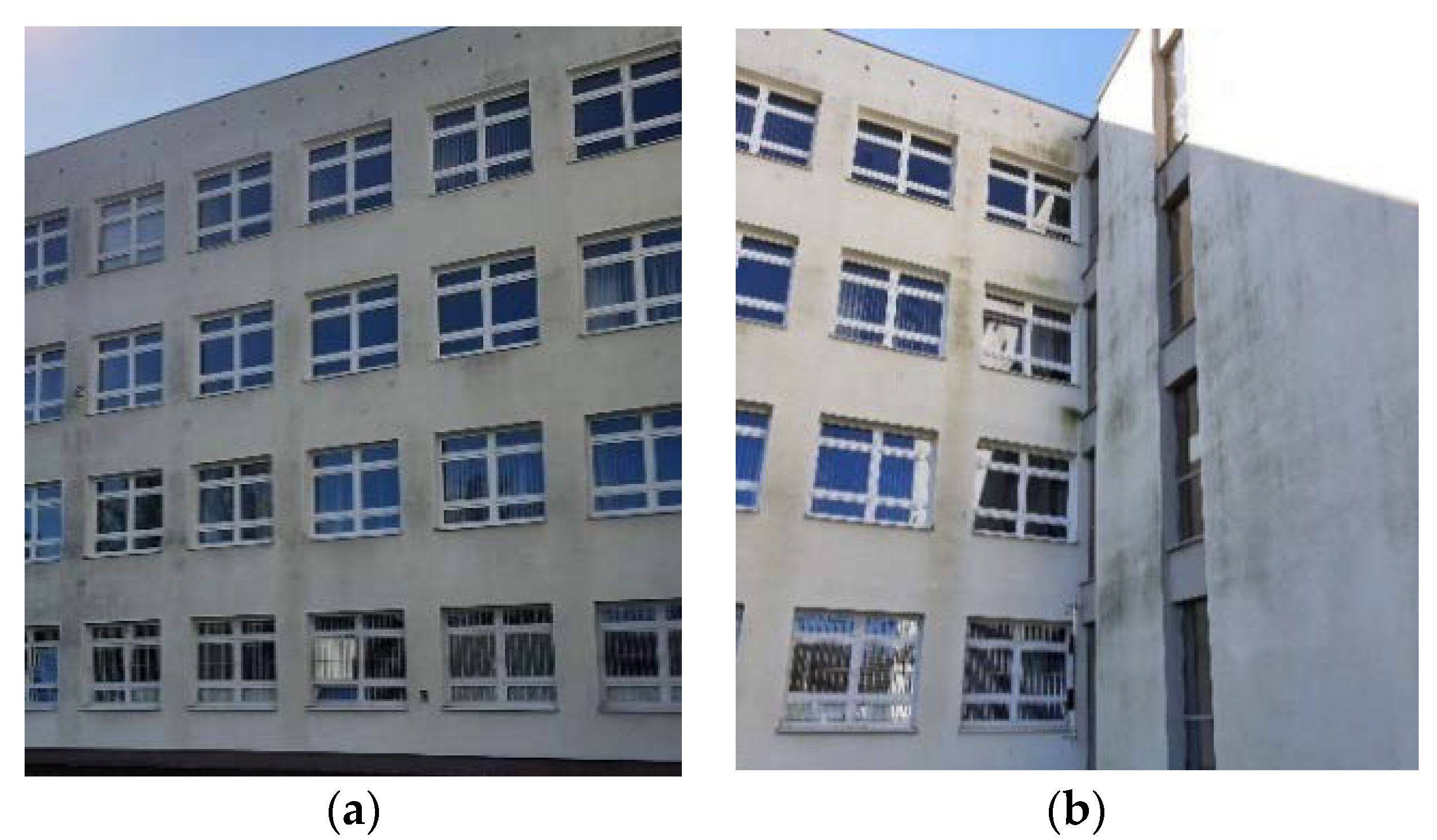
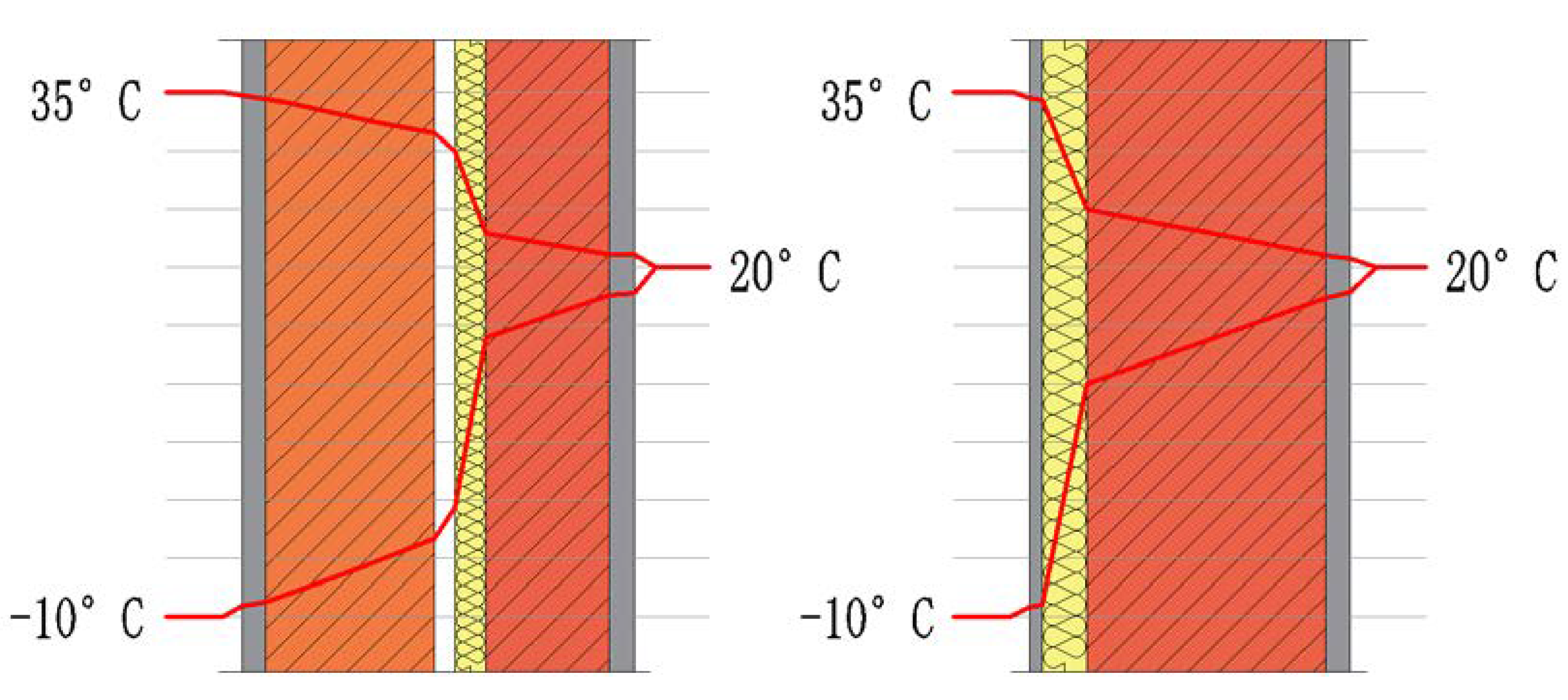
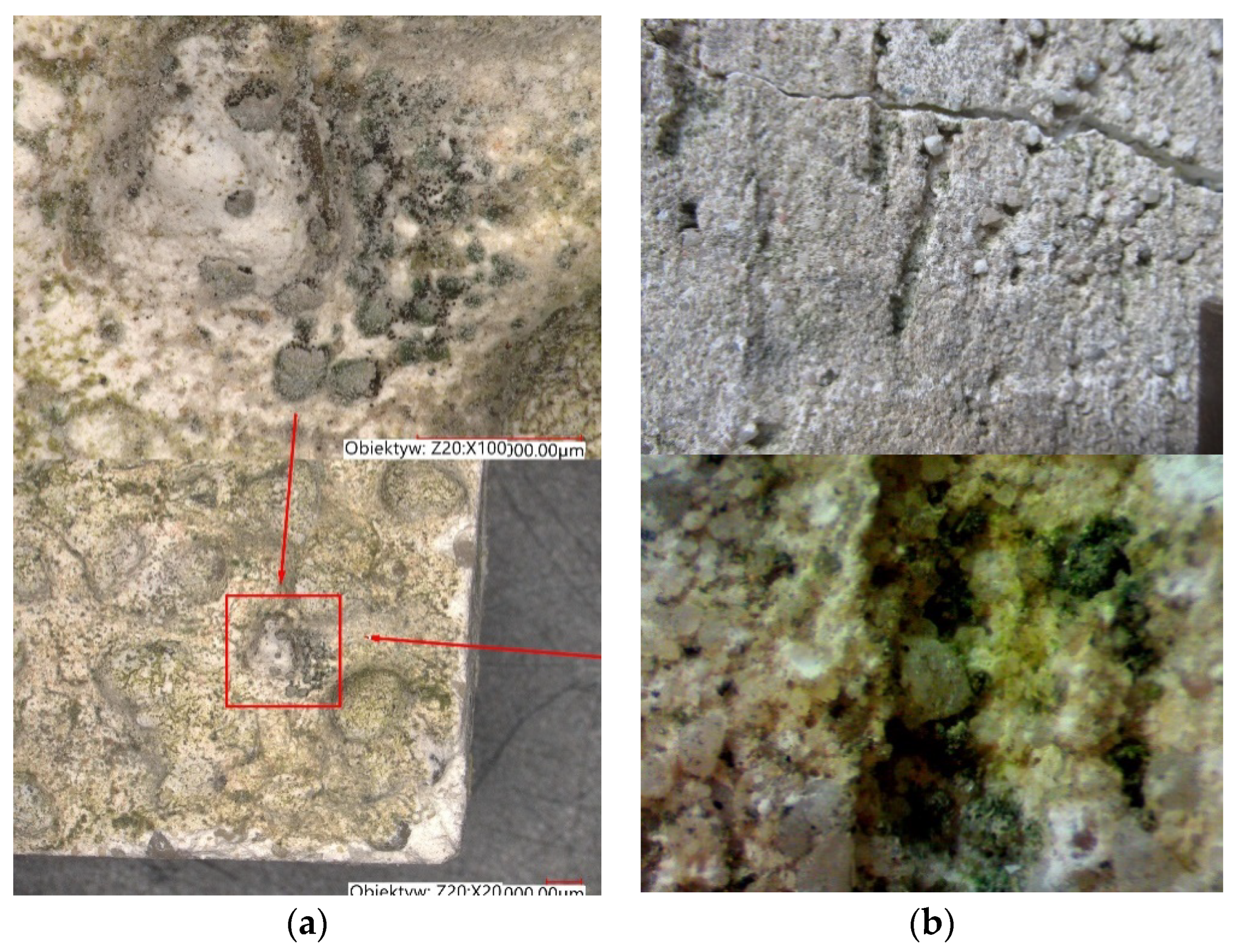

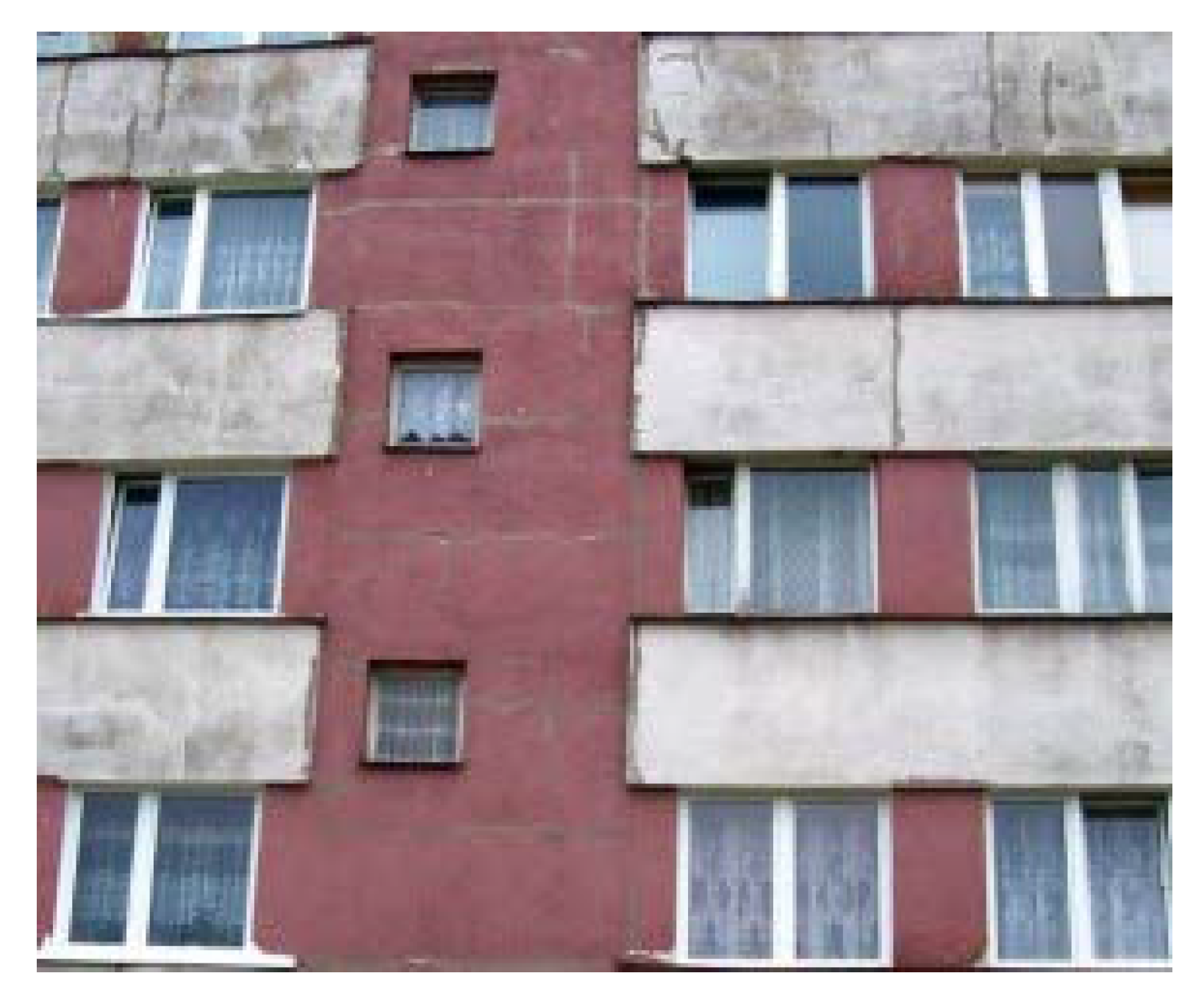

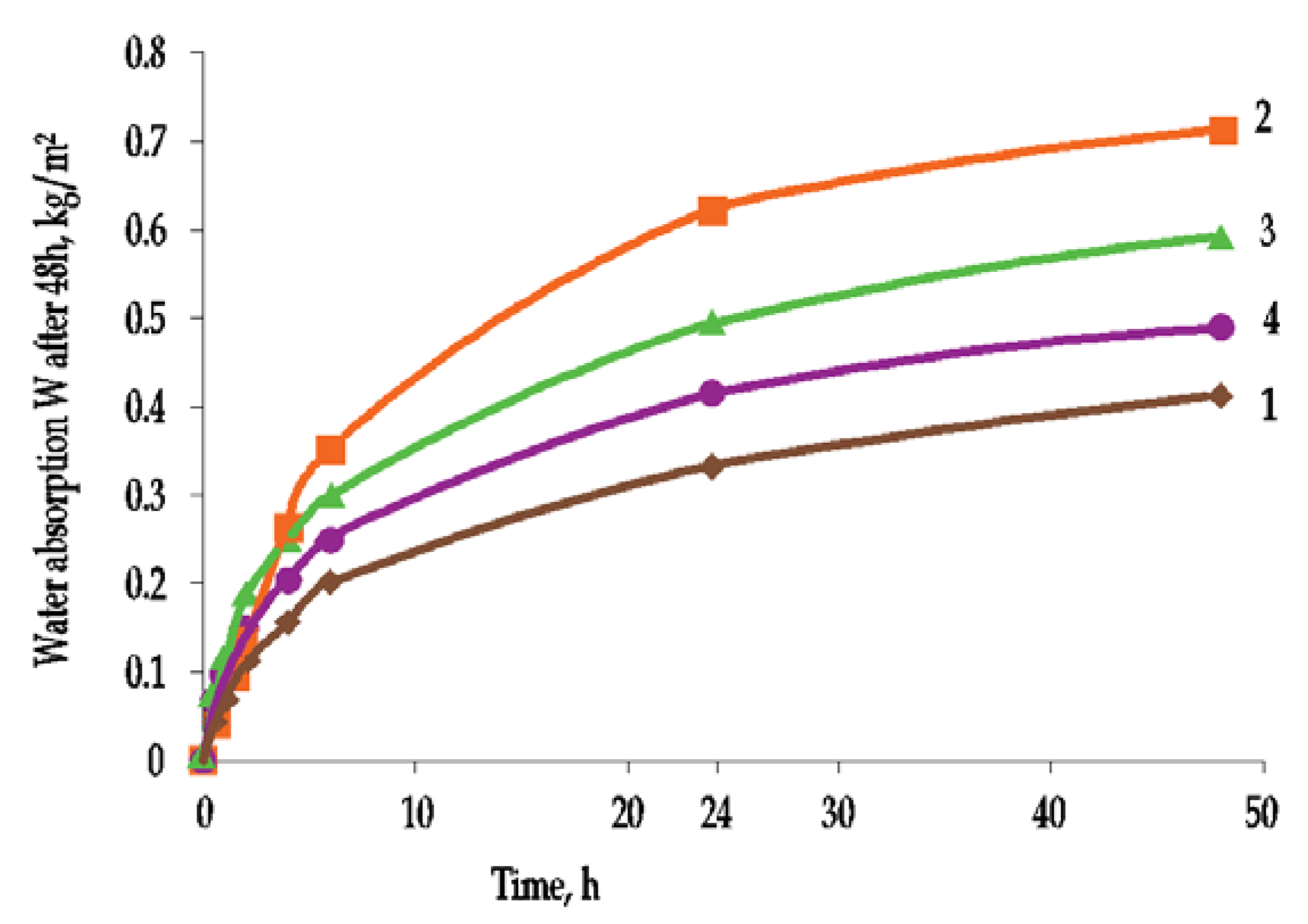
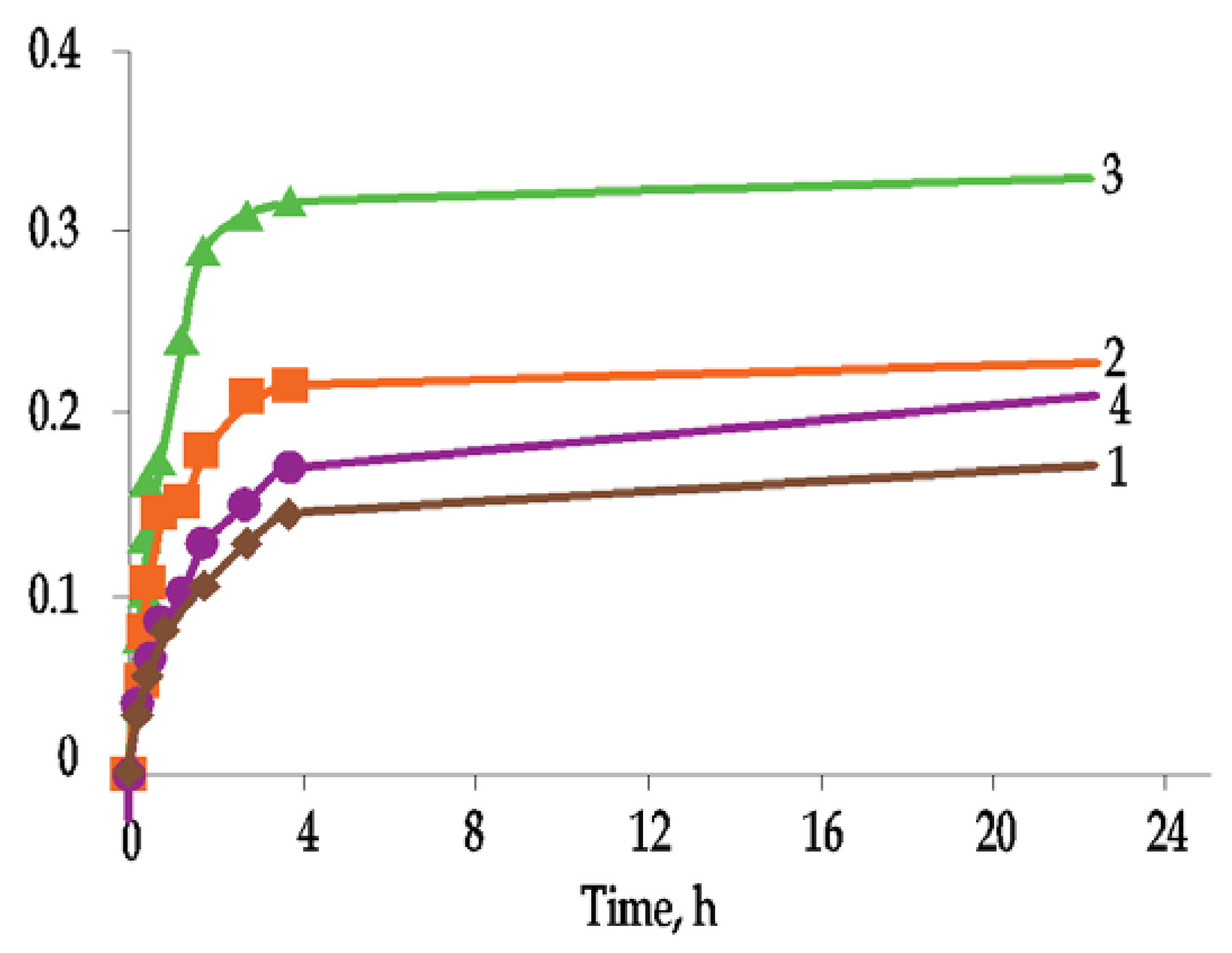

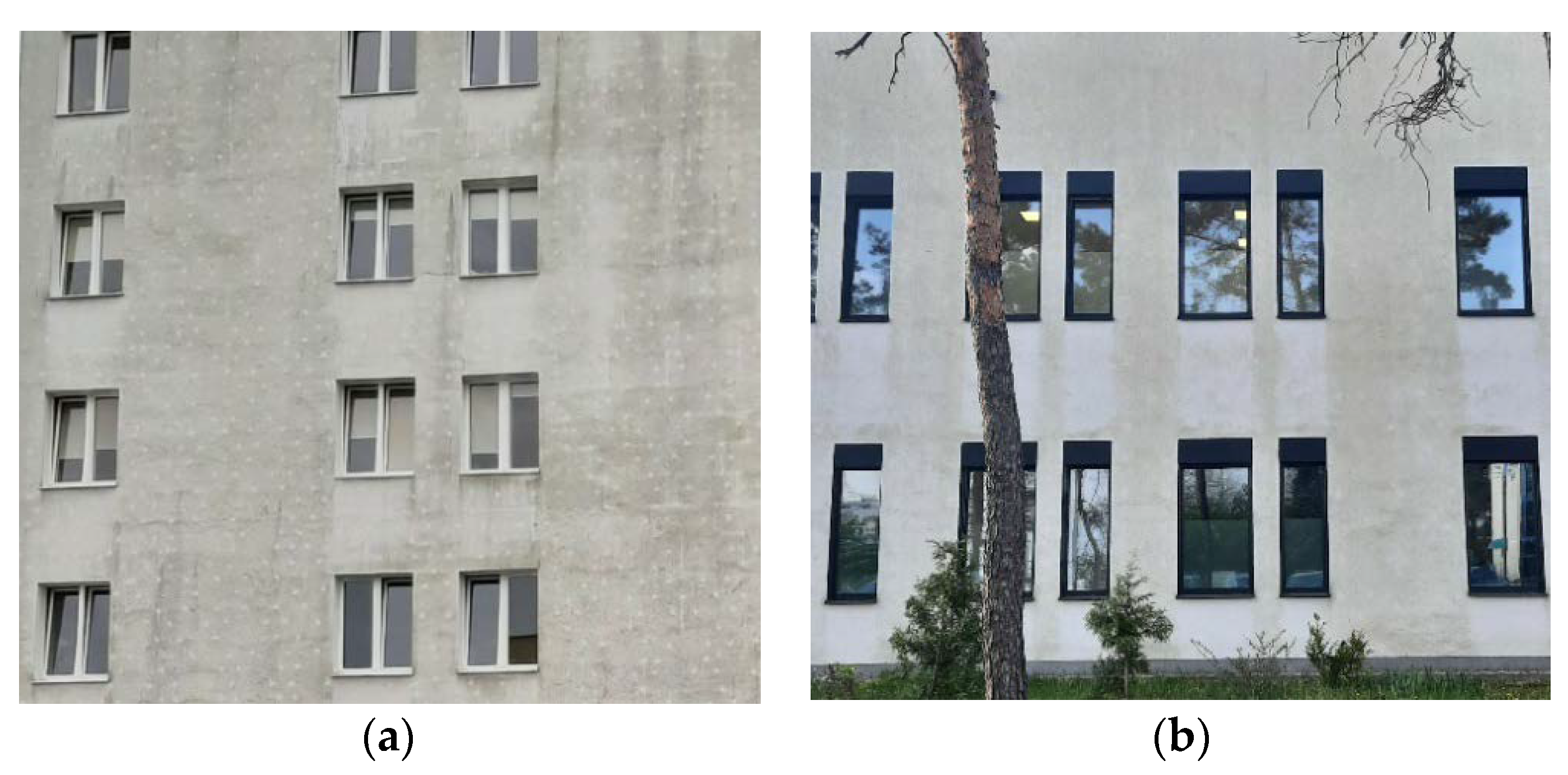
| Material | Fungus Type | Standard SampleNot Contaminated | pH after 1 Month after Contamination | pH after 6 Months after Contamination |
|---|---|---|---|---|
| Plaster | Aspergillus | 12.21 | 12.00 | 9.63 |
| Cladosporium | 12.04 | 10.40 | ||
| Penicillium | 12.06 | 10.04 |
| Type of Mortar | Total Porosity Changes (%) | ||||
|---|---|---|---|---|---|
| State 0 | 100 Cycles | 200 Cycles | 300 Cycles | ||
| Cement | sC | 8.66 | 11.46 | 12.25 | 17.63 |
| Cement-lime | sCL | 10.14 | 12.38 | 15.46 | 19.76 |
| Cement-lime Y | sLY | 8.71 | 11.65 | 12.21 | 16.94 |
| Cement E | sCE | 8.55 | 10.14 | 12.19 | 16.32 |
| Cement E + Ahydrosil | sCEA | 10.76 | 12.01 | 14.21 | 17.46 |
| Class | sd [m] | Coating Type |
|---|---|---|
| I | <0.14 | Mineral, silicone and silicate-organic |
| II | 0.14–1.4 | Acrylic with reduced binder content |
| III | >1.4 | Acrylic with high binder content |
| Plasters Properties | Influence of Plaster Properties on Microorganism Colonization | Influence of Microorganisms on Plaster Properties | ||
|---|---|---|---|---|
| Direct | Indirect | Direct | Indirect | |
| Plaster thermal capacity | (widening of temperature range supporting colonization) | (humidity changes resulting from surface condensation) | not tested | (humidity changes resulting from microstructure changes resulting from freezing and thawing of humid coatings) |
| Plaster composition | (influence of plaster type on microorganism colonization) | (humidity changes resulting from water absorption) | (in context of chemical changes) | (humidity changes resulting from microstructure changes due to freezing and thawing of humid coatings) |
| Plaster pH | (influence on microorganisms colonization) | not tested | (substrate pH changes due to microorganisms colonization) | not tested) |
| Surface structure | (roughness effect) | not tested | not tested | not tested) |
| Plaster porosity | not tested | (porosity changes due to freeze-thaw cycles and aging) | not tested | (changes resulting from microstructure, changes resulting from freezing and thawing of humid coatings) |
| System Properties | Influence of Solutions Material Layouts and Building Details on Microorganism Colonization | Influence of Microorganisms on Solutions for Material Layouts and Building Details | ||
|---|---|---|---|---|
| Direct | Indirect | Direct | Indirect | |
| Thermal requirements for envelope components | (widening of temperature range which increases colonization) | (periods of summer condensation, changes in thermal conductivity of the system due to plaster microstructure changes) | not tested | (humidity changes due to microstructure changes resulting from freeze-thaw cycles of humid coatings) |
| Plaster color scheme | not tested | (stresses in the plaster layers, cyclic material deformation, microcracks) | not tested | not tested |
| Exterior coating material systems | not tested | (humidity changes due to internal condensation) | not tested | (humiditychanges due to microstructure changes resulting from freezing and thawing of humid coatings) |
| Structural solutions of ETICS system | (in situ research of influence of anchoring system on biocorrosion development) | (increasing temperature on plaster surface in anchoring surface, changes in dynamics of drying resulting from various plaster substrate) | not tested | not tested |
Publisher’s Note: MDPI stays neutral with regard to jurisdictional claims in published maps and institutional affiliations. |
© 2021 by the authors. Licensee MDPI, Basel, Switzerland. This article is an open access article distributed under the terms and conditions of the Creative Commons Attribution (CC BY) license (https://creativecommons.org/licenses/by/4.0/).
Share and Cite
Dybowska-Józefiak, M.; Wesołowska, M. Internal Abiotic Components That Influence the Development of Biocorrosion on ETICS Plasters. Materials 2022, 15, 127. https://doi.org/10.3390/ma15010127
Dybowska-Józefiak M, Wesołowska M. Internal Abiotic Components That Influence the Development of Biocorrosion on ETICS Plasters. Materials. 2022; 15(1):127. https://doi.org/10.3390/ma15010127
Chicago/Turabian StyleDybowska-Józefiak, Monika, and Maria Wesołowska. 2022. "Internal Abiotic Components That Influence the Development of Biocorrosion on ETICS Plasters" Materials 15, no. 1: 127. https://doi.org/10.3390/ma15010127
APA StyleDybowska-Józefiak, M., & Wesołowska, M. (2022). Internal Abiotic Components That Influence the Development of Biocorrosion on ETICS Plasters. Materials, 15(1), 127. https://doi.org/10.3390/ma15010127






